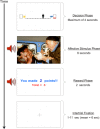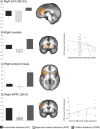Neural substrates of approach-avoidance conflict decision-making
- PMID: 25224633
- PMCID: PMC4300249
- DOI: 10.1002/hbm.22639
Neural substrates of approach-avoidance conflict decision-making
Abstract
Animal approach-avoidance conflict paradigms have been used extensively to operationalize anxiety, quantify the effects of anxiolytic agents, and probe the neural basis of fear and anxiety. Results from human neuroimaging studies support that a frontal-striatal-amygdala neural circuitry is important for approach-avoidance learning. However, the neural basis of decision-making is much less clear in this context. Thus, we combined a recently developed human approach-avoidance paradigm with functional magnetic resonance imaging (fMRI) to identify neural substrates underlying approach-avoidance conflict decision-making. Fifteen healthy adults completed the approach-avoidance conflict (AAC) paradigm during fMRI. Analyses of variance were used to compare conflict to nonconflict (avoid-threat and approach-reward) conditions and to compare level of reward points offered during the decision phase. Trial-by-trial amplitude modulation analyses were used to delineate brain areas underlying decision-making in the context of approach/avoidance behavior. Conflict trials as compared to the nonconflict trials elicited greater activation within bilateral anterior cingulate cortex, anterior insula, and caudate, as well as right dorsolateral prefrontal cortex (PFC). Right caudate and lateral PFC activation was modulated by level of reward offered. Individuals who showed greater caudate activation exhibited less approach behavior. On a trial-by-trial basis, greater right lateral PFC activation related to less approach behavior. Taken together, results suggest that the degree of activation within prefrontal-striatal-insula circuitry determines the degree of approach versus avoidance decision-making. Moreover, the degree of caudate and lateral PFC activation related to individual differences in approach-avoidance decision-making. Therefore, the approach-avoidance conflict paradigm is ideally suited to probe anxiety-related processing differences during approach-avoidance decision-making.
Keywords: anterior cingulate cortex; caudate; emotion; insula; prefrontal cortex; punishment; reward; striatum.
© 2014 Wiley Periodicals, Inc.
Figures





Similar articles
-
Test-retest reliability of approach-avoidance conflict decision-making during functional magnetic resonance imaging in healthy adults.Hum Brain Mapp. 2021 Jun 1;42(8):2347-2361. doi: 10.1002/hbm.25371. Epub 2021 Mar 2. Hum Brain Mapp. 2021. PMID: 33650761 Free PMC article.
-
Anodal transcranial direct current stimulation over right dorsolateral prefrontal cortex alters decision making during approach-avoidance conflict.Soc Cogn Affect Neurosci. 2017 Mar 1;12(3):468-475. doi: 10.1093/scan/nsw140. Soc Cogn Affect Neurosci. 2017. PMID: 27694531 Free PMC article.
-
Examining the Role of the Human Hippocampus in Approach-Avoidance Decision Making Using a Novel Conflict Paradigm and Multivariate Functional Magnetic Resonance Imaging.J Neurosci. 2015 Nov 11;35(45):15039-49. doi: 10.1523/JNEUROSCI.1915-15.2015. J Neurosci. 2015. PMID: 26558775 Free PMC article.
-
The differential neural substrates for reward choice under gain-loss contexts and risk in alcohol use disorder: Evidence from a voxel-based meta-analysis.Drug Alcohol Depend. 2023 Jul 1;248:109912. doi: 10.1016/j.drugalcdep.2023.109912. Epub 2023 May 4. Drug Alcohol Depend. 2023. PMID: 37182355 Review.
-
Neural systems underlying approach and avoidance in anxiety disorders.Dialogues Clin Neurosci. 2010;12(4):517-31. doi: 10.31887/DCNS.2010.12.4/raupperle. Dialogues Clin Neurosci. 2010. PMID: 21319496 Free PMC article. Review.
Cited by
-
Anhedonia is associated with reduced incentive cue related activation in the basal ganglia.Cogn Affect Behav Neurosci. 2015 Dec;15(4):749-67. doi: 10.3758/s13415-015-0366-3. Cogn Affect Behav Neurosci. 2015. PMID: 26105776 Free PMC article.
-
A Corticostriatal Path Targeting Striosomes Controls Decision-Making under Conflict.Cell. 2015 Jun 4;161(6):1320-33. doi: 10.1016/j.cell.2015.04.049. Epub 2015 May 28. Cell. 2015. PMID: 26027737 Free PMC article.
-
Dissociating representations of affect and motion in visual cortices.Cogn Affect Behav Neurosci. 2023 Oct;23(5):1322-1345. doi: 10.3758/s13415-023-01115-2. Epub 2023 Aug 1. Cogn Affect Behav Neurosci. 2023. PMID: 37526901 Free PMC article.
-
Subjective value then confidence in human ventromedial prefrontal cortex.PLoS One. 2020 Feb 10;15(2):e0225617. doi: 10.1371/journal.pone.0225617. eCollection 2020. PLoS One. 2020. PMID: 32040474 Free PMC article.
-
Is there a relation between novelty seeking, striatal dopamine release and frontal cortical thickness?PLoS One. 2017 Mar 27;12(3):e0174219. doi: 10.1371/journal.pone.0174219. eCollection 2017. PLoS One. 2017. PMID: 28346539 Free PMC article.
References
-
- American Psychiatric Association . (2000): Disagnostic and Statistical Manual of Mental Disorders DSM‐IV‐TR. Washington D.C: American Psychiatric Association.
-
- Atallah HE, Lopez‐Paniagua D, Rudy JW, O'Reilly RC (2007): Separate neural substrates for skill learning and performance in the ventral and dorsal striatum. Nat Neurosci 10:126–131. - PubMed
-
- Barlow DH(2002): Anxiety and Its Disorders: The Nature and Treatment of Anxiety and Panic. New York: Guilford Press.
Publication types
MeSH terms
Substances
Grants and funding
LinkOut - more resources
Full Text Sources
Other Literature Sources
Medical
Miscellaneous

